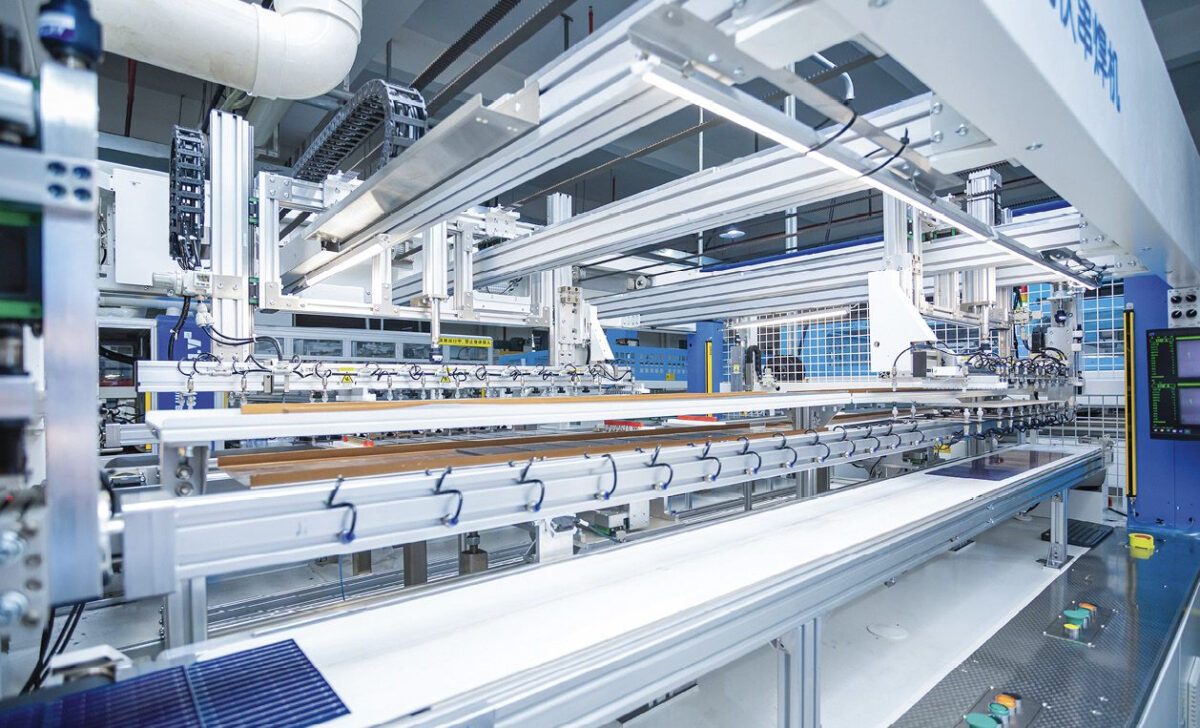FuturaSun was founded in 2008, in the medieval town of Cittadella in Italy’s Padova province. After a phase of original equipment manufacturer production and international sales of Chinese-made PV modules, the company opened a 1 GW module facility in Taizhou, in China's Jiangsu province. FuturaSun makes modules for large-scale arrays and rooftop PV systems, as well as building-integrated PV products and solar components. With a European base in northern Italy and Asian headquarters in Suzhou, China, steady growth has opened an exciting phase of upstream expansion with solar cell production in Huai’an, in Jiangsu province. That city of five million inhabitants is in the same province as FuturaSun’s headquarters and module production facilities.
A new industrial complex is being realized in two phases that will house 15 GW of solar cell production. The first-phase of construction will finish in 2023 with the first cells due in early spring 2024.
Government backing
The lightning-fast development is the result of a unique support system the Chinese government offers those companies it deems worthy after stable growth, and which have a solid business case and strong project team. Chinese cities and district governments can offer support to jump-start enterprises considered important for the region. FuturaSun should generate jobs and tax revenue and attract more businesses to expand the supply chain and boost regional knowledge.
The support package includes the provision of land, construction finance, and access to state-related investment. Repayments can be made over a designated period. The land will be leased for at least 30 years and may be renewed.
The land and buildings can be used as collateral for loans and other finance. That is a big difference from European financial arrangements, where collateral to back finance has to be provided by a company. While it could be argued that the Chinese approach is only possible in a planned economy, the West could still learn from the arrangement.
Risk remains
Success for an individual enterprise is not guaranteed and it is ultimately up to the company itself to realize its dream. The government does not provide free money and does not support a failing company; enterprises in China can – and regularly do – go bankrupt. Although the USA and China often focus on their differences, the striking resemblance between the two financial ecosystems is that both systems enable rapid and large-scale entrepreneurship due to a willingness to “burn cash” in large amounts. In Europe, financiers tend to be more cautious and risk-averse, resulting in smaller projects with much longer lead times that are also subject to complex decision making processes and bureaucracy.
It can be difficult to keep up with the speed and scale at which China expands its production capacity, especially in the field of photovoltaics. The nation’s large size gives economy-of-scale effects that result in lower production costs. Large-volume production gives more stable processes, resulting in higher yield and efficiency. Scale also enables substantial investment into research and development.
There is the human factor as well. It is difficult to compete with a nation of highly educated, highly motivated people that work more or less around the clock amid an environment featuring rapidly increasing automation, rising quality levels, and an excellent knowledge base. While Europe discusses a four-day working week, China populates R&D laboratories 24/7 and moves forward at lightning speed.
Seizing opportunity
FuturaSun is making use of the unique opportunities offered in China while maintaining and expanding its strong base in Italy. It is building bridges between East and West. The company provides a welcome counterpoint to what has become a more strained relationship between China and Western countries. FuturaSun’s plans include developing new headquarters in Suzhou plus a considerable expansion of its module production capacity, an R&D center, and a new office building.
In Cittadella, a piece of land has been acquired for a new Italian headquarters and for a gigawatt-scale module production facility to be erected. The company has also invested in the startup Solertix, a spin-out from Rome’s Tor Vergata university that specializes in the development of perovskite modules.
FuturaSun has engaged in a partnership with German PV research institute ISC Konstanz and licensed its Zebra technology for back-contact solar cells. Zebra cells will be produced in the new cell factory in Huai’an and incorporated into state-of-the art modules in Cittadella.
Fast pace
Earlier in 2023, I had the pleasure of visiting several suppliers of production equipment for solar cells and modules for FuturaSun’s new production plant. In my role as the company's technical adviser, I was asked to assess quality and the industrial readiness of the different systems and processes available. In what I experienced as an intense two-week road trip, the team and I visited several suppliers and manufacturers per day, traveling all over the region.
Technical meetings alternated with official receptions and banquets with local government to learn about support programs and opportunities offered by different regions. Government officials proactively try to invite businesses in the renewable energy industry to invest in their region and even compete – sometimes fiercely – with other regions.
The speed and scale of things I witnessed were mind-boggling. From maximum 30-day decision-making periods on big projects advertised by some local governments, to machine-building companies that can assemble the equivalent of 40 GW of modern solar production equipment per month, to the construction site of a well-known tier one PV manufacturer we visited. This is where, in less than nine months, a 600,000 m² green field was being transformed into a fully operational multi-gigawatt factory complex for cells and modules.
On leaving the site, where newly erected buildings were still visibly missing windows, and excavators and other machinery were crisscrossing the location, we passed by a whole range of production equipment that was already waiting to move in on a seemingly endless line of trucks. I remembered that many years ago, I visited companies in China that were visibly struggling with quality and organization. Today, a very different picture emerges. The latest factories are clean, well-organized, and efficient. The scale and speed of development are hard to grasp.
The leading turnkey company, for example, has already supplied 400 GW per year of production equipment to market for tunnel oxide passivated contact cells, the latest in commercial crystalline silicon technology. And that in little more than a year. In its workshops, endless rows of machines are assembled by thousands of workers.
Ambition required
I left humbled and impressed by what I had seen. Europe struggles to bring back part of the value chain for the production of renewable energy products – items that should be, and are, fortunately, now increasingly regarded as highly strategic and critical for national safety and survival. Now all Europe needs to do is to put cash to work as it can vicariously learn from its neighbors to the east and west.
Bringing back the solar industry requires bold entrepreneurship and huge, potentially risky, investment. Only sufficient scale, hard work, and clever innovation can bring back an industry that can be competitive and, ultimately, successful in today’s globalized market. To achieve that, Europe should try to cooperate with China rather than exclude it or revert to blunt protectionism. The greatest strength lies in joining forces.
 About the author: Erik Eikelboom holds an MSc. in solid state physics. He has been active in the PV industry since 1992 in various roles ranging from fundamental materials research through to PV systems. He works as a consultant and technical adviser with FuturaSun.
About the author: Erik Eikelboom holds an MSc. in solid state physics. He has been active in the PV industry since 1992 in various roles ranging from fundamental materials research through to PV systems. He works as a consultant and technical adviser with FuturaSun.
The views and opinions expressed in this article are the author’s own, and do not necessarily reflect those held by pv magazine.
This content is protected by copyright and may not be reused. If you want to cooperate with us and would like to reuse some of our content, please contact: editors@pv-magazine.com.



By submitting this form you agree to pv magazine using your data for the purposes of publishing your comment.
Your personal data will only be disclosed or otherwise transmitted to third parties for the purposes of spam filtering or if this is necessary for technical maintenance of the website. Any other transfer to third parties will not take place unless this is justified on the basis of applicable data protection regulations or if pv magazine is legally obliged to do so.
You may revoke this consent at any time with effect for the future, in which case your personal data will be deleted immediately. Otherwise, your data will be deleted if pv magazine has processed your request or the purpose of data storage is fulfilled.
Further information on data privacy can be found in our Data Protection Policy.